
For those who are interested in classic touring bicycles that combine speed, maneuverability and comfort, we live in interesting times. Such bicycles have gained in popularity over the past several years, with many custom framebuilders and manufacturers introducing touring models into their line-ups. And while trends like this are not easy to trace, I think it is fair to say that Grant Petersen of
Rivendell and Jan Heine of
Bicycle Quarterly deserve a great deal of the credit.
Rivendell is a small bicycle manufacturer witha distinct philosophy, which they promote with a tireless output of literature. The
Bicycle Quarterly (review here) is a niche cycling magazine, with a focus on classic bicycles in the French
randonneur tradition.
To the untrained eye, the type of bicycle promoted by these two camps may seem similar, if not identical: lugged steel frames, wide tires, fenders, racks, classic luggage, leather saddles. But in fact, there are major differences as far as geometry and historical lineage go, and these differences have been inspiring impassioned debates among bicycle connoisseurs for years.
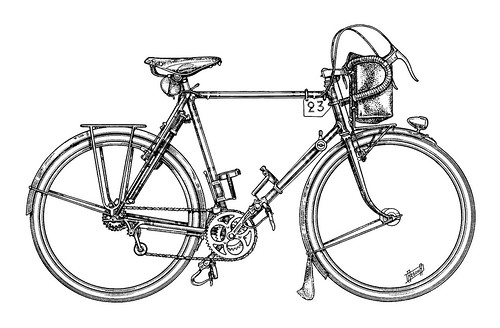 [image via stronglight]
[image via stronglight]When it comes to frame geometry,
Rivendell's emphasis is on relaxed angles and clearance for wide tires.Theresulting bicycles are fast, stable, comfortable, and have excellent off-road capacity. The bicyclechampioned by
Bicycle Quarterly is rather more specific. Jan Heine believes that bicycles made in the French
randonneur tradition - which had reached its height in the 1940s and 50s before its recent resurrection - offer an unrivaled combination of speed and comfort. These bicycles are aggressive and maneuverable, yet cushy and easy to control. They are super light, yet designed to carry a great deal of weight. The main difference from
Rivendell structurally, is that such bicycles have what is known as "low trail geometry" while
Rivendell bicycles have "mid trail geometry." The difference cannot be easily summed up here, but suffice to say that this factor controls the bicycle's responsiveness, and that mid trail is considered classic whereas low trail is more exotic - not often seen outside the early French tradition. In addition, Jan Heine insists on wide 650B tires, lack of toe overlap, and integrated features such as racks and dynamo lighting. Grant Petersen does not place as much emphasis on 650B tires per se, considers toe overlap to be a non-issue, and does not take lighting into consideration when designing frames.
If these differences seem too subtle for those not familiar with frame design, let me rephrase it like this: The bikes may
look similar, but they are built differently and ride differently, and there is some debate about which is "better."
 [image via protorio]
[image via protorio]As a reader of both
Rivendell literature and
Bicycle Quarterly, I am equally convinced by Petersen
and Heine; both arguments make sense while I'm reading them. But they can't both be right, because some of their views are in direct opposition!
Since I own a
Rivendell and have now ridden close to 2,000 miles on it, it would be fantastic to try a classic
randonneur with low trail and 650B wheels for comparison. The problem is that these bicycles are extremely rare. To try one, I would need to either find a vintage
Rene Herse or
Alex Singer in my size to test ride - which is next to impossible, as they are not exactly the kind of bike a neighbour would have lying around in their garage, or commission a new one custom built just for me by the handful of framebuilders who specialise in them, or find someone who
has commissioned such a bike, is the same size as me, and would be willing to lend it to me for a test ride. As neither option is realistic, my interest in classic
randonneurs seems destined to remain hypothetical. Has anybody out there actually tried both a
Rivendell and a traditional
randonneur?
 After our way too short of a visit there, we headed over to see Ambir and Auburn. One, or both of them, maybe be moving in with us so we had lots to talk about. We took Ace back home with us, which thrilled Aric because he is close to Ace. Ace is HUGE now! He's still sweet as could be though, so it's hard to take his size all too seriously.
After our way too short of a visit there, we headed over to see Ambir and Auburn. One, or both of them, maybe be moving in with us so we had lots to talk about. We took Ace back home with us, which thrilled Aric because he is close to Ace. Ace is HUGE now! He's still sweet as could be though, so it's hard to take his size all too seriously.





 Sometimes I get emails where ladies send me pictures of their bicycle and ask whether I think "it would look better" with dress guards and/or a chaincase. Ladies... You do realise that these things are not there for the looks, right? Although a set of dress guards and a chaincasedo lend a certain charm to a bicycle, aesthetics are not their primary purpose. So let me explain why I put them on my bikes, and then you can decide for yourself whether you need them or not.
Sometimes I get emails where ladies send me pictures of their bicycle and ask whether I think "it would look better" with dress guards and/or a chaincase. Ladies... You do realise that these things are not there for the looks, right? Although a set of dress guards and a chaincasedo lend a certain charm to a bicycle, aesthetics are not their primary purpose. So let me explain why I put them on my bikes, and then you can decide for yourself whether you need them or not.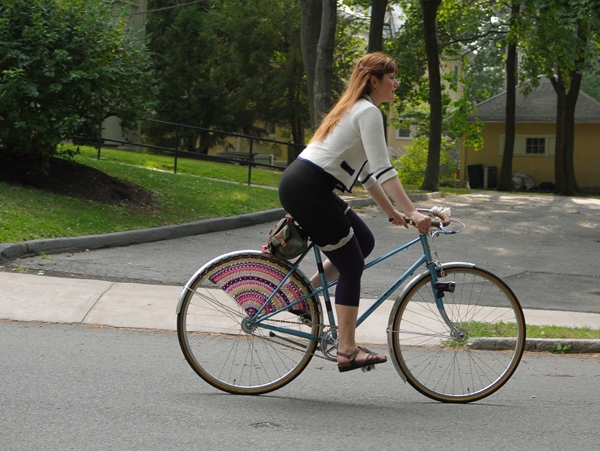 The purpose of dress guards is to stop fluttery, loose clothing from flying into the spokes of your rear wheel and either getting ruined or causing an accident.The main determinant of whether you need dressguards is whether you wearthe sort of clothing that requires their protection - for instance: flared skirts, dresses, long coats, or flowing tunics. Once you have had something get stuck in your rear spokes or have seen it happen to someone else, you know that the possibility is real and that it can even cause injury. Personally,I will not ride a bicycle without dress guards if an article of clothing I am wearing is long enough to reach the rear spokes. And since much of my everyday clothing is in that category, it is a good idea for me to install dress guards on any bike I plan to use for transportation.
The purpose of dress guards is to stop fluttery, loose clothing from flying into the spokes of your rear wheel and either getting ruined or causing an accident.The main determinant of whether you need dressguards is whether you wearthe sort of clothing that requires their protection - for instance: flared skirts, dresses, long coats, or flowing tunics. Once you have had something get stuck in your rear spokes or have seen it happen to someone else, you know that the possibility is real and that it can even cause injury. Personally,I will not ride a bicycle without dress guards if an article of clothing I am wearing is long enough to reach the rear spokes. And since much of my everyday clothing is in that category, it is a good idea for me to install dress guards on any bike I plan to use for transportation. I have also been asked what kind of dressguards are better: netted or solid. There are probably differing opinions on this, but in my experience it does not matter. My vintage Raleigh(above) is fitted with very minimal dressguards that are basically just stretchy cords fanning out from the rear dropouts. For me, this has been sufficient; the cords - closely spaced - provide a perfectly functional barrier.The obvious advantage to dress guards that are woven, is that they are lighter (and usually more attractive) than plastic ones. The disadvantage is that they can be more expensive and more difficult to clean.
I have also been asked what kind of dressguards are better: netted or solid. There are probably differing opinions on this, but in my experience it does not matter. My vintage Raleigh(above) is fitted with very minimal dressguards that are basically just stretchy cords fanning out from the rear dropouts. For me, this has been sufficient; the cords - closely spaced - provide a perfectly functional barrier.The obvious advantage to dress guards that are woven, is that they are lighter (and usually more attractive) than plastic ones. The disadvantage is that they can be more expensive and more difficult to clean. Moving on to chaincases, their purpose is two-fold: (1) to prevent the bottoms of your trousers from being caught in the chain, and (2) to keep the chain clean from street grime, especially in bad weather. Since I seldom wear long trousers, the first function is not that important to me. So while I do appreciate that the chaincase keeps my chain nice and clean, this accessory is not as crucial for me as dress guards, because it is a maintenance feature rather than a safety feature. I can still ride a bike without a chaincase for transportation.
Moving on to chaincases, their purpose is two-fold: (1) to prevent the bottoms of your trousers from being caught in the chain, and (2) to keep the chain clean from street grime, especially in bad weather. Since I seldom wear long trousers, the first function is not that important to me. So while I do appreciate that the chaincase keeps my chain nice and clean, this accessory is not as crucial for me as dress guards, because it is a maintenance feature rather than a safety feature. I can still ride a bike without a chaincase for transportation. Furthermore, while I have found dress guards to be effective in preventing clothing from getting stuck in the spokes, I have not found chaincases to be entirely effective on those rare occasions when I do wear trousers. A couple of times, the bottoms of my trousers have actually gotten stuck on the chaincase itself, which has only increased my bias for skirts once I started cycling. Don't get me wrong, I still love a nice, elegant chaincase. But I admit that this feature does not hold as much functional purpose for me as do dress guards.
Furthermore, while I have found dress guards to be effective in preventing clothing from getting stuck in the spokes, I have not found chaincases to be entirely effective on those rare occasions when I do wear trousers. A couple of times, the bottoms of my trousers have actually gotten stuck on the chaincase itself, which has only increased my bias for skirts once I started cycling. Don't get me wrong, I still love a nice, elegant chaincase. But I admit that this feature does not hold as much functional purpose for me as do dress guards.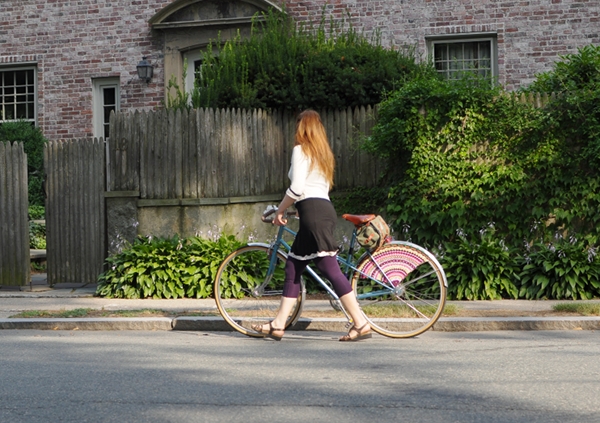 Dress guards and chaincases are not affectations, but necessary accessories for transportation in everyday clothing. As the popularity of "city bikes" rises, I hope that more American bicycle shops will realise this, and start carrying these useful items.
Dress guards and chaincases are not affectations, but necessary accessories for transportation in everyday clothing. As the popularity of "city bikes" rises, I hope that more American bicycle shops will realise this, and start carrying these useful items.
 For those who are interested in classic touring bicycles that combine speed, maneuverability and comfort, we live in interesting times. Such bicycles have gained in popularity over the past several years, with many custom framebuilders and manufacturers introducing touring models into their line-ups. And while trends like this are not easy to trace, I think it is fair to say that Grant Petersen of Rivendell and Jan Heine of Bicycle Quarterly deserve a great deal of the credit. Rivendell is a small bicycle manufacturer witha distinct philosophy, which they promote with a tireless output of literature. The Bicycle Quarterly (review here) is a niche cycling magazine, with a focus on classic bicycles in the French randonneur tradition.
For those who are interested in classic touring bicycles that combine speed, maneuverability and comfort, we live in interesting times. Such bicycles have gained in popularity over the past several years, with many custom framebuilders and manufacturers introducing touring models into their line-ups. And while trends like this are not easy to trace, I think it is fair to say that Grant Petersen of Rivendell and Jan Heine of Bicycle Quarterly deserve a great deal of the credit. Rivendell is a small bicycle manufacturer witha distinct philosophy, which they promote with a tireless output of literature. The Bicycle Quarterly (review here) is a niche cycling magazine, with a focus on classic bicycles in the French randonneur tradition.




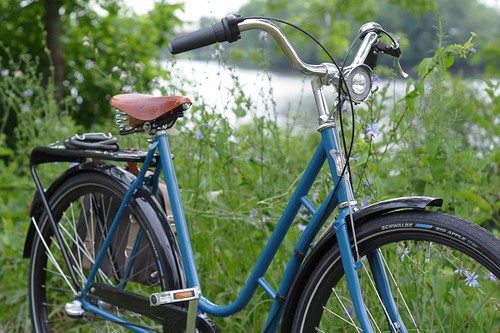 I was outside the post office, unstrapping a bundle of packages from my bike's rear rack, when a woman walking past with a toddler looked at the bicycle and smiled.
I was outside the post office, unstrapping a bundle of packages from my bike's rear rack, when a woman walking past with a toddler looked at the bicycle and smiled. Today we headed over to Yorktown. While driving around, we came across this monument. We hadn't even heard of this monument before, so we felt quite lucky that we did happen upon it. It was just gorgeous!
Today we headed over to Yorktown. While driving around, we came across this monument. We hadn't even heard of this monument before, so we felt quite lucky that we did happen upon it. It was just gorgeous! Some fun facts:
Some fun facts: Lady Victory, a younger sister to the Statue of Liberty, exquisitely tops a slender pedestal of Maine granite. In 1956, replacement of the original figure of liberty, damaged by lightening, took place.
Lady Victory, a younger sister to the Statue of Liberty, exquisitely tops a slender pedestal of Maine granite. In 1956, replacement of the original figure of liberty, damaged by lightening, took place. The shaft is 84 feet high and Liberty is 14 feet high.
The shaft is 84 feet high and Liberty is 14 feet high. This is a monument that we are sure to remember!
This is a monument that we are sure to remember! Living the life in Historical Virginia!
Living the life in Historical Virginia!
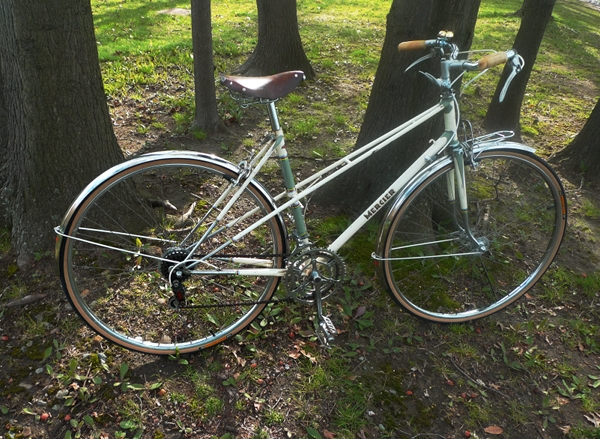 Pictured here are my latest additions: fenders, front rack, bell, and stem shifters.
Pictured here are my latest additions: fenders, front rack, bell, and stem shifters. For fenders, I chose the inexpensive stainless steel fenders from
For fenders, I chose the inexpensive stainless steel fenders from 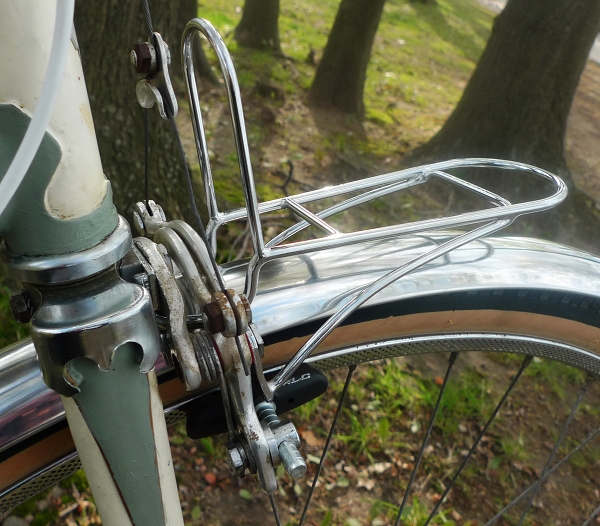 And this is the tiny, adorable vintage
And this is the tiny, adorable vintage 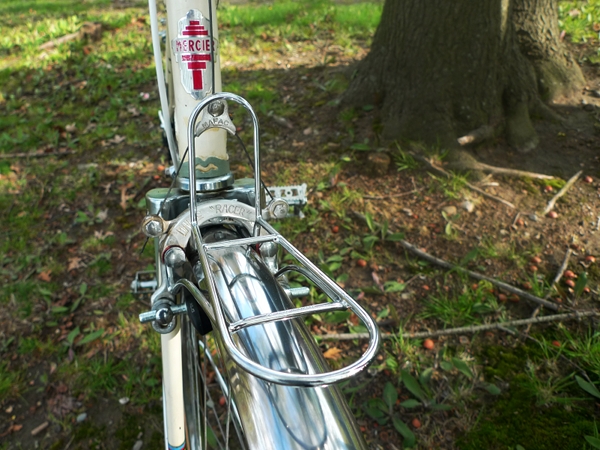 The rack, while very cute, is so small that I am not sure what I will put on it. A classic touring handlebar bag does not really fit the look of this bike, but I will keep thinking. What did the French put on bicycles with these handlebars?
The rack, while very cute, is so small that I am not sure what I will put on it. A classic touring handlebar bag does not really fit the look of this bike, but I will keep thinking. What did the French put on bicycles with these handlebars?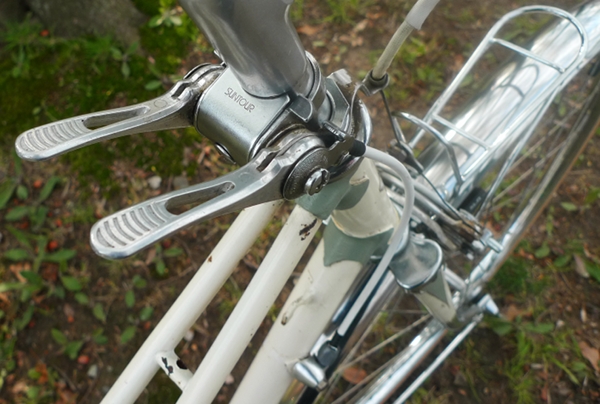 Finally, we replaced the original
Finally, we replaced the original  All of this does sound like a lot of fuss about an old bike. But in a way, it is the
All of this does sound like a lot of fuss about an old bike. But in a way, it is the 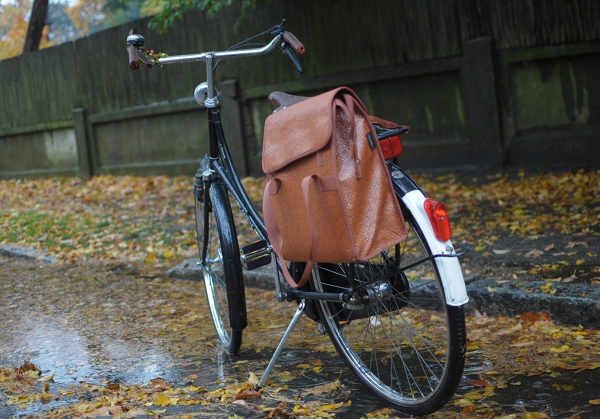 In the morning they did warn me
In the morning they did warn me And so November is upon us, and with it the November Rain. Funny, because I don't remember it being quite this bad last year, but I've probably just blocked it out. Today it rained so hard, that the water not only covered my face, but went inside my nose and mouth. Feeling as if I might drown while cycling was a curious sensation. I could hardly see anything in front of me, but thankfully drivers seemed to all be showing remarkable courtesy. Maybe they just couldn't believe that a cyclist was on the road in such a downpour and felt sorry for me.
And so November is upon us, and with it the November Rain. Funny, because I don't remember it being quite this bad last year, but I've probably just blocked it out. Today it rained so hard, that the water not only covered my face, but went inside my nose and mouth. Feeling as if I might drown while cycling was a curious sensation. I could hardly see anything in front of me, but thankfully drivers seemed to all be showing remarkable courtesy. Maybe they just couldn't believe that a cyclist was on the road in such a downpour and felt sorry for me.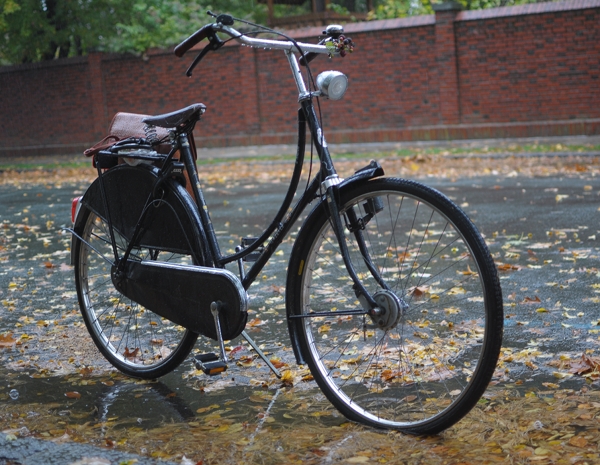 When it is raining this hard, I prefer to be on a heavy, upright, and exceptionally stable bike.When I owned my Pashley, I often talked of how good it was for cycling in the rain. To my relief, the vintageGazelle is the same, if not better. The handling makes this bike unfellable. The enormous wheels and wide tires part lake-sized puddles, grip slippery surfaces, and float over potholes. The fenders release a mighty spray and keep my beige raincoat beige. Defiant in the downpour, I cycled with dignity even as water streamed down my face. And I arrived at my destinations only slightly worse for wear.
When it is raining this hard, I prefer to be on a heavy, upright, and exceptionally stable bike.When I owned my Pashley, I often talked of how good it was for cycling in the rain. To my relief, the vintageGazelle is the same, if not better. The handling makes this bike unfellable. The enormous wheels and wide tires part lake-sized puddles, grip slippery surfaces, and float over potholes. The fenders release a mighty spray and keep my beige raincoat beige. Defiant in the downpour, I cycled with dignity even as water streamed down my face. And I arrived at my destinations only slightly worse for wear.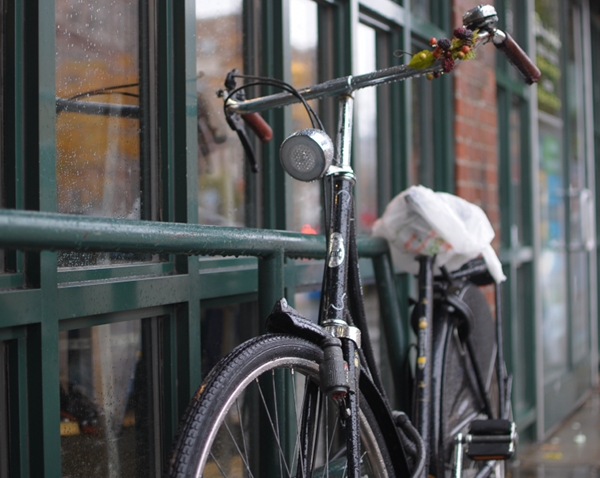 The other two things I like to have when cycling in the rain are good lights and a saddle cover. I was not sure how well the bottle dynamo would function when wet, but it was absolutely fine (I am beginning to develop a fondness for the bottle) - and my LED-modified headlight made me highly visible. As for the saddle cover, despite having accumulated many Brooks covers at this point, my preferred method is to use a ratty plastic grocery bag. The plastic bag performs two functions: it is more waterproof (gasp!) than a Brooks saddle cover, and it makes the bicycle look considerably less appealing to thieves. Not that many thieves would be tempted to drag away a 50lb clunker with a locked rear wheel in a downpour...
The other two things I like to have when cycling in the rain are good lights and a saddle cover. I was not sure how well the bottle dynamo would function when wet, but it was absolutely fine (I am beginning to develop a fondness for the bottle) - and my LED-modified headlight made me highly visible. As for the saddle cover, despite having accumulated many Brooks covers at this point, my preferred method is to use a ratty plastic grocery bag. The plastic bag performs two functions: it is more waterproof (gasp!) than a Brooks saddle cover, and it makes the bicycle look considerably less appealing to thieves. Not that many thieves would be tempted to drag away a 50lb clunker with a locked rear wheel in a downpour...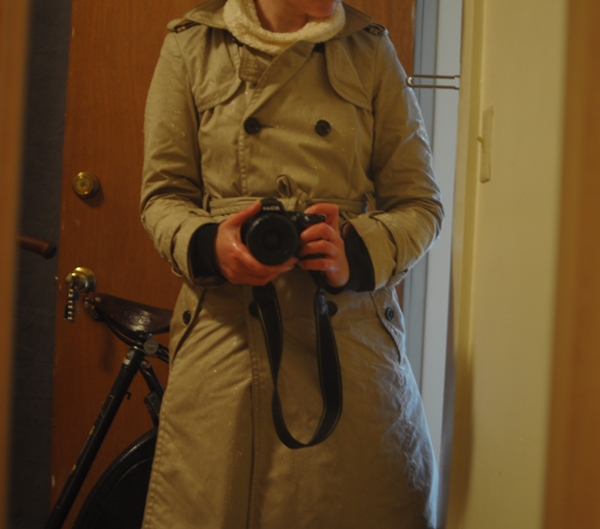 And speaking of dragging: I must say that carrying a wet, slippery 50lb bicycle up the stairs is even more delightful than doing so with a dry one. I have noticed that when it comes to lifting a heavy step-through, it is important to find a comfortable spot to grip - one that is well balanced and will prevent the bicycle from twisting or buckling in my arms as I attempt to maneuver it. Despite being heavier than my previously-owned Pashley, the Gazelle has a better "sweet spot" in this regard, and so I find it easier to carry... just not when the frame is slick from the rain. Still, I managed to wrestle the enormous Dutch creature up the stairs and through the door without either of us taking a spill, after which we had a cup of tea and recited poetry together. It is essential to have a bicycle that is more than a fair weather friend.
And speaking of dragging: I must say that carrying a wet, slippery 50lb bicycle up the stairs is even more delightful than doing so with a dry one. I have noticed that when it comes to lifting a heavy step-through, it is important to find a comfortable spot to grip - one that is well balanced and will prevent the bicycle from twisting or buckling in my arms as I attempt to maneuver it. Despite being heavier than my previously-owned Pashley, the Gazelle has a better "sweet spot" in this regard, and so I find it easier to carry... just not when the frame is slick from the rain. Still, I managed to wrestle the enormous Dutch creature up the stairs and through the door without either of us taking a spill, after which we had a cup of tea and recited poetry together. It is essential to have a bicycle that is more than a fair weather friend.
 The Phend plot at South Park Cemetery, Whitley County, Indiana.
The Phend plot at South Park Cemetery, Whitley County, Indiana. Henry and Susie Phend, my great grandparents, with their infant son Richard Lincoln.
Henry and Susie Phend, my great grandparents, with their infant son Richard Lincoln. Virgil Gilbert Phend, son of Henry and Susie.
Virgil Gilbert Phend, son of Henry and Susie. Rolland Victor Phend, my grandfather, son of Henry and Susie.
Rolland Victor Phend, my grandfather, son of Henry and Susie.










